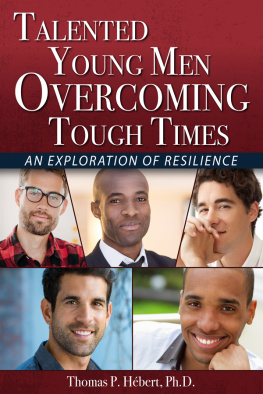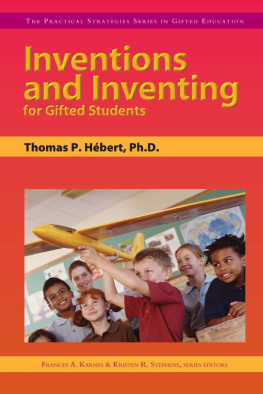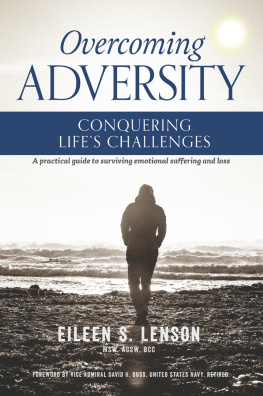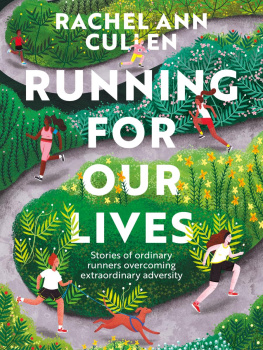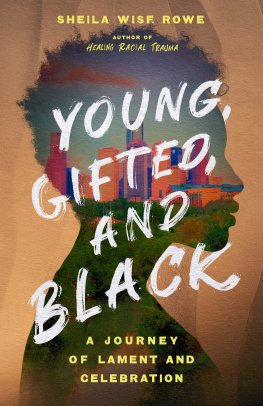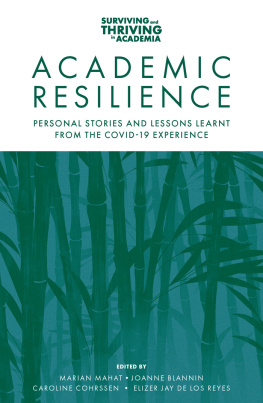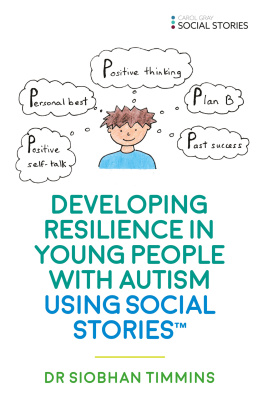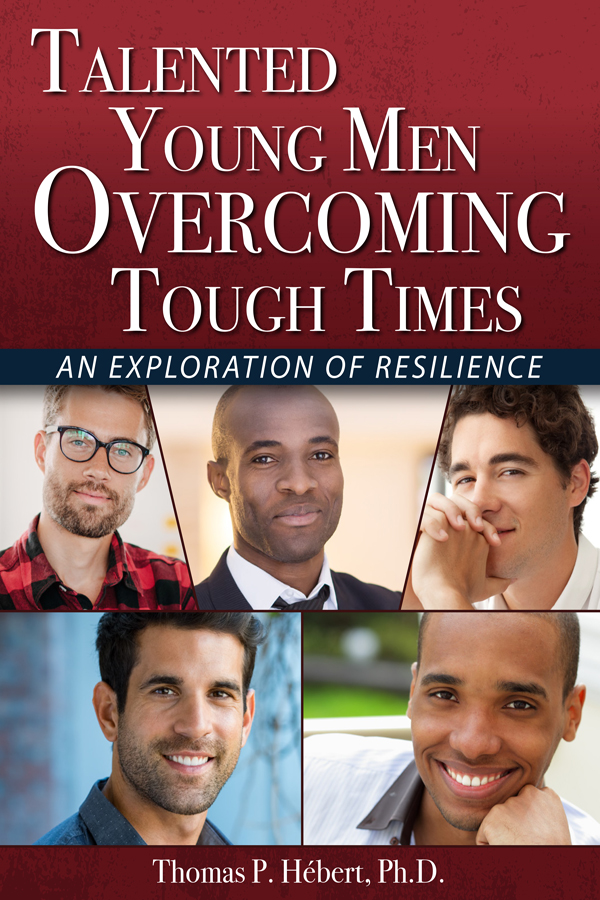


Copyright 2018, Prufrock Press Inc.
Edited by Lacy Compton
Cover and layout design by Micah Benson
ISBN-13: 978-1-61821-914-5
No part of this book may be reproduced, translated, stored in a retrieval system, or transmitted, in any form or by any means, electronic, mechanical, photocopying, microfilming, recording, or otherwise, without written permission from the publisher.
For more information about our copyright policy or to request reprint permissions, visit https://www.prufrock.com/permissions.aspx.
Printed in the United States of America.
At the time of this books publication, all facts and figures cited are the most current available. All telephone numbers, addresses, and website URLs are accurate and active. All publications, organizations, websites, and other resources exist as described in the book, and all have been verified. The authors and Prufrock Press Inc. make no warranty or guarantee concerning the information and materials given out by organizations or content found at websites, and we are not responsible for any changes that occur after this books publication. If you find an error, please contact Prufrock Press Inc.

| Prufrock Press Inc.
P.O. Box 8813
Waco, TX 76714-8813
Phone: (800) 998-2208
Fax: (800) 240-0333
http://www.prufrock.com |
Table of Contents
Dedication
In memory of my father, J. Paul Hbert, whose life continues to provide me inspiration and personal strength.
Acknowledgments
I would like to thank my friend Jean Peterson for her thorough review of my work. Her insights and thoughtful critique helped to strengthen this book. I appreciate her important contributions.
I would like to thank my colleagues in gifted education who introduced me to the five gifted young men presented in this work. These dedicated educators enabled me to conduct my study.
I also want to thank Joel McIntosh and his staff at Prufrock Press, particularly Katy McDowall for her dedication to this project.
I especially want to thank my editor Lacy Compton, who remained committed to this project as we made this journey together.
I am most indebted to the five gifted men who openly shared their lives with me so that we might all learn from them.
INTRODUCTION
University colleagues assured me that my life would change. I had been promoted to the rank of full professor. I had reached the professional stage of my career in higher education when I would no longer have to worry about meeting the expectations of another committee on tenure and promotion. I had made it to the top. I could begin to have fun!
I reflected on a recorded song from the late 1960s that my parents often played on the familys stereo. The renowned American jazz singer Peggy Lee sang Is That All There Is? In that tune she described the bewilderment she felt as a young girl when she arrived at a circus and saw clowns and elephants and dancing bears, yet felt that something was missing. She continued to sing about anticlimactic events in life and wrapped up the chorus with If thats all there is, then Ill keep dancing (Leiber & Stoller, 1969). I felt the same. I had achieved the final promotion but realized I needed to keep dancing. I searched for new challenges that would keep me intellectually engaged and passionate about my scholarly interests.
I discovered that my university offered a competitive faculty research leave. This program enabled professors to enjoy a mini-sabbatical. The thought of taking time off from the routine of teaching classes and participating in endless committee meetings sounded wonderful. With time away from campus, I could focus on a new research project and become reinvigorated. I submitted my research proposal, and shortly after, I celebrated when I learned I had been granted a semesters leave.
Until that time, my research had explored the social and emotional development of gifted young people, with many of my scholarly manuscripts focused on gifted males. I had also studied intelligent adolescents whose lives beyond school were filled with serious challenges. I chose to continue this line of inquiry. My new study, which led to this book, would examine the experiences of high-achieving talented males who had overcome serious adversity. I wanted to investigate young men thriving in university life or in the early stages of their professional careers. For this study I would explore two overarching questions. I wanted to understand how these high-achieving gifted males overcame adverse circumstances to reach high levels of achievement. Moreover, I wanted to understand and appreciate the relationships that had guided their behaviors, attitudes, and aspirations.
I turned to my friends in the field of gifted and talented education throughout the country. I asked public school teachers and university educators to nominate young men for my study. I was gratified that so many colleagues were happy to help. They recommended young men they had worked with in their settings and introduced them to me. I was delighted with the diverse group of men who became the subjects for my research.
My colleagues initiated a conversation with each of the individual young men to explore whether they would be willing to participate in the study. When they agreed, I communicated with them via e-mail and described my proposed research. I explained that I would travel to their community and spend a week in their contexts to conduct extensive qualitative interviews with each of them individually. I needed uninterrupted time with them in order to capture their complete life stories. I was able to negotiate a calendar with each of them, and they graciously afforded me the time I needed for the interviews. Once dates were determined, I moved forward with travel plans.
The men in the study had all left their hometowns and were living in various places throughout the country. Although I was meeting them in their new professional contexts, the earlier chapters of their life stories had occurred elsewhere. My travels began in January and lasted through May. In some cases, I was able to travel by car; other experiences involved airline flights and car rentals. Each trip involved some personal anxiety. The thought of traveling to a new community and making connections with the young men I had never met seemed intimidating at first. I wondered, Would they be open to me?, Would they like me?, and Would I be able to develop a comfortable rapport quickly enough? I also imagined that the men were probably asking similar questions about me.
My colleagues who had recommended the participants were critical to my success. They served as important gatekeepers and opened the way for me to make connections with the men. These educators had assured the men that they would enjoy working with me and that their contributions to this research would be significant. I quickly discovered that I would enjoy my semester working with them. The men were delightful to work with. Although they had difficult stories to share with me, I realized that the experience was likely therapeutic for them. I believe that their involvement in my research also served as validation for their having created successful, meaningful lives. Through this work, I made significant new friendships, and I remain connected to each of them today. This book features the life stories of five intelligent young men who have important experiences to share with us. I present each of them to you in separate chapters. The concluding chapter presents my thematic analysis of the findings from this study and highlights the scholarly literature to reinforce their significance.
Next page
